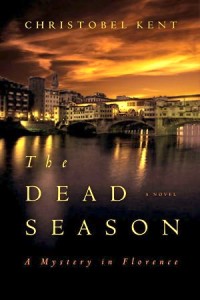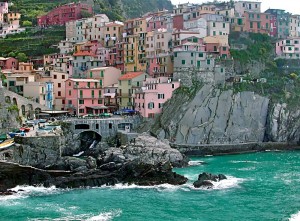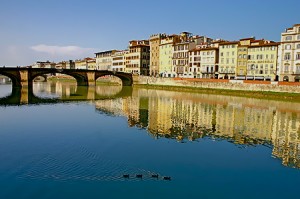“Thirty-one degrees [89 F] three hours before dawn, and not a breath of cooler air anywhere in the city. Even the moon, shining perfectly round and white overhead, seemed to give out heat. During the day there were distractions but at night, in those long dead hours between midnight and dawn when by rights the world should be cooling, the heat bore down like a weight…”
 During the one week in August in which the action in this novel takes place, the city of Florence is almost claustrophobic with the heat, with temperatures over a hundred degrees (Fahrenheit), paralyzing the city during the day, with no respite at night. Many residents have decamped for the hills or the ocean to escape, and those who remain behind, usually without air conditioning, must simply add the day’s heat to the other aspects of life which they must endure, even in a city as beautiful as this one. In a welcome change from the darkly violent noir novels which have been so popular among mystery aficionados in recent years, author Christobel Kent uses this setting to create a character-based “summer mystery,” focusing on several groups of characters as they cope with the summer heat and with a mystery which the author presents through their eyes. The novel is effectively plotted, with plenty of excitement, but it develops as the outcome of the characters’ actions and their thoughts as they deal with a disappearance and the eventual determination of murder, rather than through author-initiated violent twists, turns, and fast-paced dramatic action in which the characters are pawns of the author. The unique characters reflect many different aspects of life in a realistically depicted Florence, not the Florence to which tourists flock on competitive shopping sprees. As in any other city, crime does exist here. Murders and disappearances do take place, and innocent people are often tormented by the impact of these crimes on their lives. The heat just adds to the intensity.
During the one week in August in which the action in this novel takes place, the city of Florence is almost claustrophobic with the heat, with temperatures over a hundred degrees (Fahrenheit), paralyzing the city during the day, with no respite at night. Many residents have decamped for the hills or the ocean to escape, and those who remain behind, usually without air conditioning, must simply add the day’s heat to the other aspects of life which they must endure, even in a city as beautiful as this one. In a welcome change from the darkly violent noir novels which have been so popular among mystery aficionados in recent years, author Christobel Kent uses this setting to create a character-based “summer mystery,” focusing on several groups of characters as they cope with the summer heat and with a mystery which the author presents through their eyes. The novel is effectively plotted, with plenty of excitement, but it develops as the outcome of the characters’ actions and their thoughts as they deal with a disappearance and the eventual determination of murder, rather than through author-initiated violent twists, turns, and fast-paced dramatic action in which the characters are pawns of the author. The unique characters reflect many different aspects of life in a realistically depicted Florence, not the Florence to which tourists flock on competitive shopping sprees. As in any other city, crime does exist here. Murders and disappearances do take place, and innocent people are often tormented by the impact of these crimes on their lives. The heat just adds to the intensity.

With four stand-alone novels and three written as part of the Sandro Cellini series, of which this is the third, author Christobel Kent shows her long literary experience, creating a can’t-put-it-downer which is so smooth that the reader is swept along, yielding to the tide of events and to the charm of the many characters while also being engrossed and actively involved trying to figure out who has committed the dastardly deed of murder.
The novel opens with the discovery of a man’s body which has been lying off the road for two days, almost totally hidden. While it could have been a suicide by someone who has deliberately walked into traffic, the damage to the body is so extensive and its location is so hidden that it is obvious to Sandro Cellini, a former officer with the Polizia dello Stato, now a private investigator, that this is a murder case. Cellini is representing a young pregnant woman whose fiancé is missing. Since her fiance has been working on an apartment for them and the baby, she is sure that he would never have left her voluntarily. Soon several other sets of characters, all concerned about the identity of the same body, become part of the milieu. Kent has a cast of characters who keep the interest high as Sandro Cellini, unassociated with the police (except through his former buddy Pietro, with whom he meets privately) investigates on behalf of his penniless client and others with whom he shares a warm, even paternal relationship.

Santa Croce, with the statue of Dante Alighieri
Three levels of characters include Sandro Cellini and his wife Luisa, married many years and still devastated by the loss of their only child, after only a day and a half of life. Luisa, who has worked for years for a fashion boutique, has also suffered from breast cancer, and she is hoping that they will soon be able to move from their neighborhood into a larger apartment in a different, safer neighborhood. They are mentors to Guili, a woman in her early forties who has been a drug addict and ex-con and who is now working part-time for Sandro as a receptionist/secretary and part-time for a women’s center. She is the person who has introduced Sandro to his penniless client, Anna Niescu, a young, shy, pregnant woman, working at a down-at-the-heels lodging house/hotel, run by an old woman who works her hard and suffers no excuses for slacking off. Anna’s fiancé is a mystery man who introduces the third set of characters – those who operate a small Florentine bank: the manager, the prideful assistant manager, a teller, and a man who works (or

Monterosso, the beach resort to which the Brunelli family retreats
loafs) at the bank. Anna’s boyfriend Josef has always arrived on time at the bank, once a week, with the weekend receipts of a nearby cinema, and his failure to make a deposit during the week of this novel raises questions about where he is and whether he might have been the victim discovered beside the road.
Gradually, the characters overlap, their relationships developing and their connections to the community expanding. Florence is a “small town” in terms of its relationships among long-time residents, and as Sandro Cellini investigates, he uses his own connections, as do his wife and the various other characters, to try to figure out the who, how, and why of the murder. Eventually, another body is discovered, and the process continues, with all the characters then looking for connections, real or imagined, between the two deaths.

Ponte Alle Grazie, where Sandro meets with Pietro, his former colleague - one bridge away from the Ponte Vecchio
Author Christobel Kent creates a taut and psychologically intriguing novel about characters dealing with crises of life-changing dimensions during a period in which the August heat ratchets up the drama by its claustrophobic intensity. The characters as a group are pragmatic people dealing with life on their own terms, and as they try to come to grips with the changes that circumstances may be hurling their way, they evoke great sympathy from the reader. Sandro Cellini, different from the more typical private eye/former police officer in that he is not a drunk, not a loner, and not a “hard” man, draws the reader’s attention to some of the smaller issues which are of particular interest to him, and as he reaches out to the people around him, providing emotional help, a characteristic rare among main characters of mysteries, he elevates his status as a hero. All the characters associated with Cellini and his wife Luisa are good people, and it is satisfying for the reader to be able to empathize with them as they live their lives. As the novel comes to a grand climax, the reader races to keep up with the action, hoping, all the while, that the characters with whom s/he has identified will survive the crises to go on with their lives in a way that is as satisfying for them as this novel has been for the reader.

Photos, in order: The author’s photo by Donald Robertson appears on the author’s page on http://us.macmillan.com
Santa Croce, built between 1224 and 1442, containes frescoes by Giotto and the tomb of Niccolo Machiavelli. Dante’s statue is outside its entrance. http://www.ssqq.com
Monterosso, the beachfront resort, appears on http://www.planningatour.com
The Ponte Alle Grazie from which most of the photos are taken of the Ponte Vecchio, its neighbor, is shown on http://www.casadeitintori.it
I was startled to discover that this Lamborghini is owned by the Polizia dello Stato, though I have no idea of its national purpose. http://www.militaryphotos.net
ARC: Pegasus
